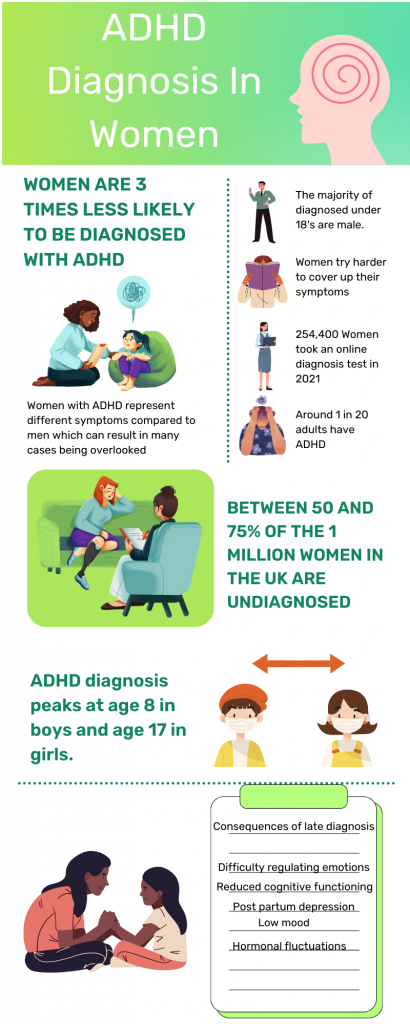You’re impulsive, too talkative, careless, unorganised, and the list goes on. These are only a few of the observations many women with ADHD face daily. Now the struggle is becoming greater as studies show women are three times less likely to be diagnosed compared to men.
ADHD – Attention Deficit Hyperactivity Disorder – is a behavioural condition known to be displayed as restlessness, impulsivity, and lack of concentration. It is a disorder that stems from atypical brain development; scientists are still studying the causes and risk factors to reduce the number of cases, however various factors have been linked to ADHD including genetics, brain injury, tobacco or alcohol use during pregnancy, and premature birth.
The diagnosis of ADHD is typically done during childhood, although the typical symptoms can be similar to other mental illnesses including anxiety, depression, or developmental disorders like autism, whereas in other cases, these may just be normal manifestations for a child.

As mentioned, the stereotypical symptoms reflect hyperactivity, portrayed as fidgeting and the inability to stand or sit still, which are predominately seen in boys. What many tend to overlook is the other type of ADHD known as ‘non-hyperactive inattentive’, manifesting as disorganisation, forgetfulness, inability to focus and emotional sensitivity, which is more common in females.
For this matter, a possible cultural misrepresentation has been created, which prevents girls as well as women from being diagnosed. According to the ADHD Foundation, girls tend to mask their symptoms as their maturing process begins earlier than boys, and potentially grow up to just simply accept their ‘issues’ with concentrating, memory loss, and impulsivity.
ADHD can also present itself in various aspects including but not limited to:
- Sensitive personality and people pleasing behaviour
- Career – Unable to meet deadlines – pressure to complete workload
- Finances – Impulsive spending disregarding consequences
- Dopamine chase – Constant search for stimulation which can lead to unnecessary risk taking
Kate, 27, has lived her whole life believing that she just wasn’t ‘normal’. She spent years reflecting and trying to self diagnose, in hopes of finding the answer to her questions. Kate grew up being described as a day dreamer and a money spending addict, she believed she was just an avid fashion enthusiast with potential anxiety.
“I remember when I was in school, I would wake up feeling anxious, before I would leave the house, my heart would get a sinking feeling, when I would get picked on in class, that feeling would reappear – so I self diagnosed myself with anxiety. I was very confused about what was wrong with me, before deciding to reach out for professional help, my memory and concentration were at their worst, but I didn’t necessarily believe to have ADHD since I have always been a fairly organised individual, and being late was my worst nightmare.”
Kate described feeling like the world was ahead of her and often felt too slow to catch up to the people around her. She explained to have found every aspect of life challenging, with the main reason being her struggle to relate to others’ calm behaviour.
Once COVID-19 struck, her mental health felt to be worsening, her daily routine became tangled and regular things began to feel uncontrollable. This is when she finally put her foot down and decided to seek medical help, which could hopefully give her an appropriate diagnosis. Then she found out she had ADHD.
Although this did not come as a shock, she had never thought of herself as part of this category, mainly because her knowledge of ADHD was limited; once again like many others, she was only aware of the hyperactivity aspect of the disorder.
“I only realised I could have ADHD when I found myself being overly analytical over my own person – I started overthinking every word I spoke and every interaction I had; it drove me crazy.”
It has been two years since Kate’s formal diagnosis, yet the news did not make it far, her fear of judgement impeded her from even telling her close family. Additionally, Kate continues to refuse to open up to her employer and colleagues, possibly due to her worries about becoming a burden in her workplace, and slowly no longer being trusted with important projects.
“I still struggle on a daily basis, although starting therapy helped understand myself better. I have improved my habits and therapy has helped manage workload and how to become better at meeting deadlines.”
It is important for women to seek help if they consider to need it. ADHD is not just a childhood disorder and should be recognised for what it is. Women in particular should not have to hide behind a self-fabricated persona just to be accepted into society; ADHD is more common than you would think.
Words: Andreea Bejan | Subbing: Lumi Leinonen


Be the first to comment on "Women with ADHD are fighting for diagnosis"